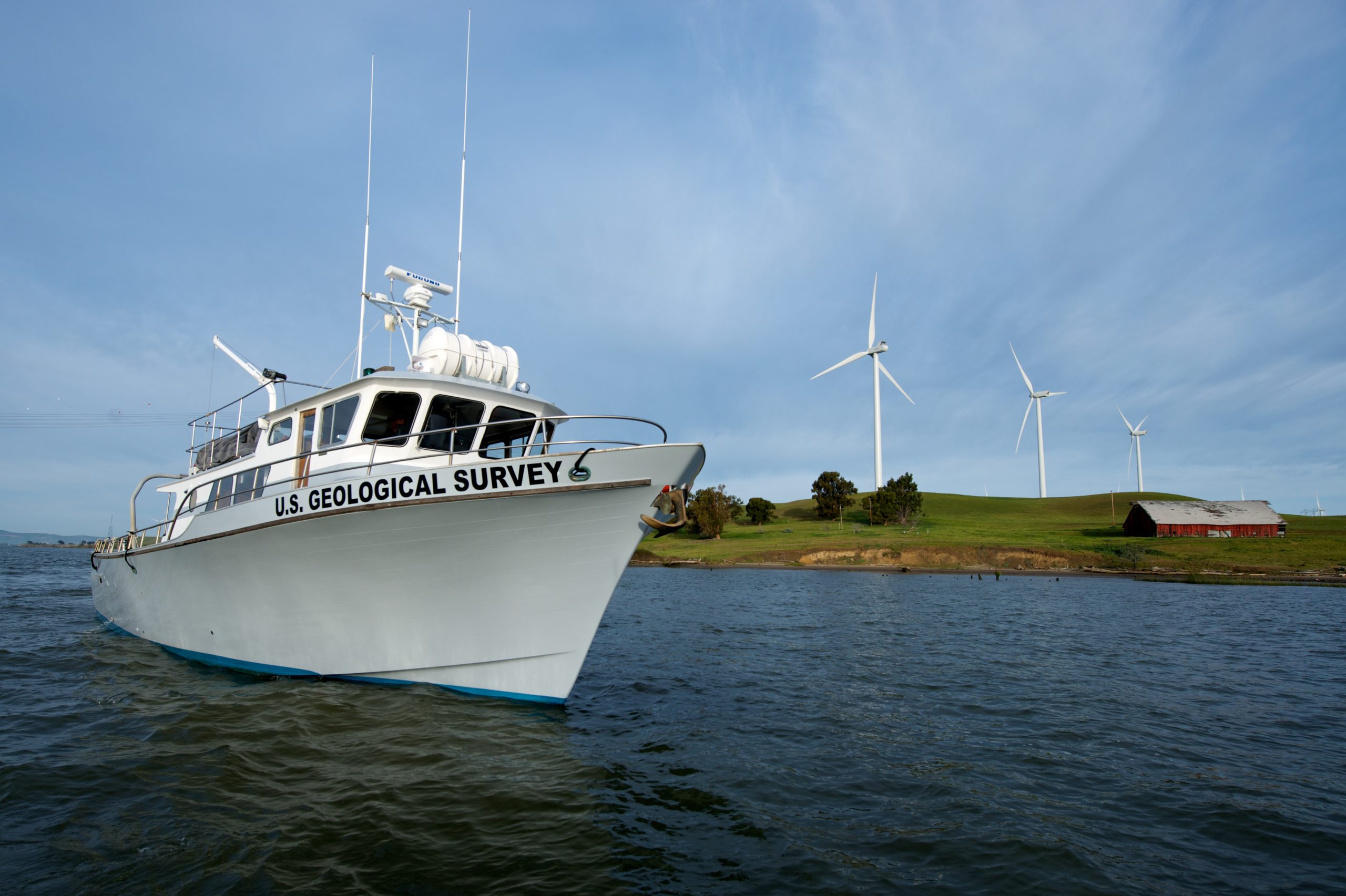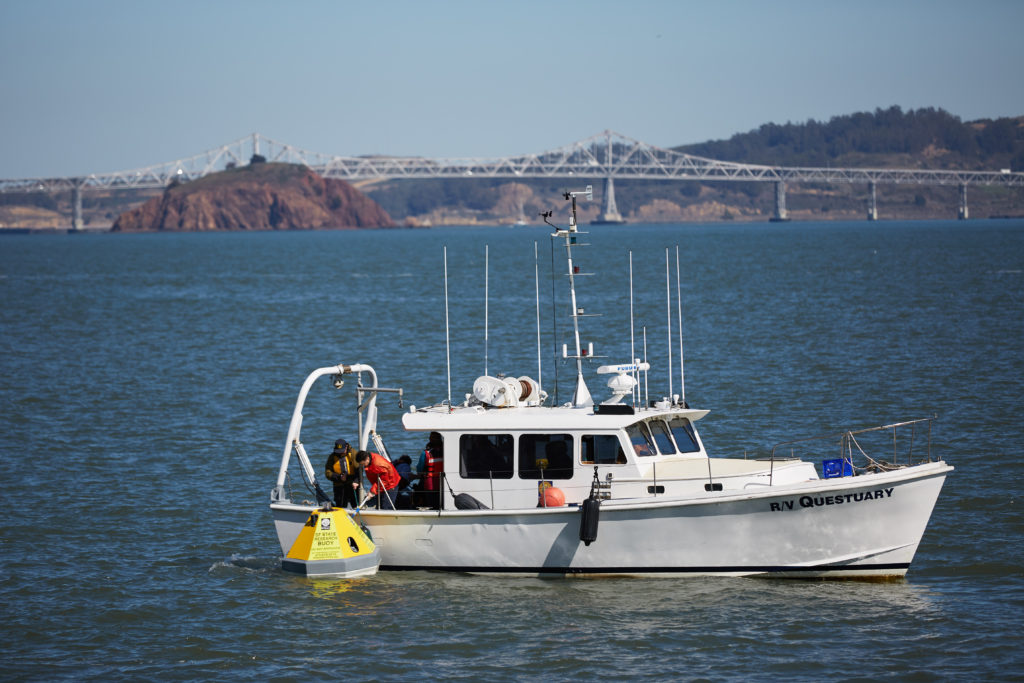
The naming of boats and ships is a serious matter. Each larger vessel’s name starts with a code that tells what it carries, what propels it, or what purpose it serves. If it were your hobby to keep tabs on traffic on San Francisco Bay, you’d see a lot of big UCCs (container ships) and TCHs and TCRs (tankers). You’d see ferries emblazoned with MV, standing for “motor vessel.” Before COVID-19, you would have spotted the occasional SS, standing for “single screw” but meaning a passenger liner. And if you looked hard you might see the occasional modest hull labeled RV. RV stands for research vessel. Seeing these letters, you know you’re looking at one of the indispensable craft that take scientists and their gear to collect data from the waters and sediments of San Francisco Bay and the Delta.
Watching Bay-Delta science unfold, we take for granted the little armada that keeps it all going. But, like many of the systems that quietly sustain our society, this one is showing signs of strain.
Nobody has a firm count, but it appears there are about 100 vessels supporting research in the Estuary. They range from a few large craft that can work outside the Golden Gate to little “trailerable” skiffs and Adirondack rowboats that ply Delta shallows. Some, like the U.S. Geological Survey’s RV Turning Tide, belong to federal agencies. Others, like the California Department of Fish and Wildlife’s RV Longfin, are state-owned. Important ones, like San Francisco State’s RV Questuary, are university assets and double as floating classrooms. Still others, like Dixon Marine’s RV Lakota, belong to private companies that lease them out to clients such as the San Francisco Estuary Institute (SFEI), Chevron, and PG&E.

About half of this fleet is enrolled with the Interagency Ecological Program, a research cooperative set up in the 1970s to track the effects of water projects and mainly, though not entirely, focused on the Delta. The other half, working largely in the lower Estuary, has not until now had such an organizational umbrella.
Depending on task, research boats need different refinements. Those that tow nets require big A-frame winches to hoist loads in and out of the water. Other boats may make do with lighter “davit” winches. They all need lab space, or at minimum a clean area for filtering and storing water samples. They need various special instruments. And they need crews adept in the special demands of operating a boat for research. “Driving a boat for science is different from driving a boat for other purposes,” says Melissa Foley of SFEI.
This under-appreciated support system has been stretched thin for years. Many vessels, or “hulls” in the language of the field, are approaching the end of their useful lives. Like an old car, an old boat starts having problems two and three at a time. Take the case of the RV Longfin, launched in 1983 and vital to generations of Bay studies. “It’s one thing after the next,” says Steve Culberson of the Interagency Ecological Program (IEP). “As soon as you fix the hydraulics, the exhaust manifold goes down. We’re using scotch tape and baling wire to hold these things together. You need to buy a couple of 1.5- to 2-million-dollar boats every decade to keep the information coming.”
Captains, crews, and maintenance staff are also getting older. San Francisco State’s RV Questuary rocks at the dock in San Rafael, having lost two captains in succession. Now there is a university hiring freeze. Not many young people are mastering the particular skills that make what you might call a research-support mariner.

State and federal environmental budgets are unpredictable and generally shrinking, leading to a kind of hoarding. Boat-owning agencies are less willing and able to lend their craft to projects outside their core missions and to people from other organizations. The informal swaps and mutual favors that have lubricated the machinery — “Oh, you’re going to Liberty Island, could you scoop up a couple of liters for our zooplankton work?” — become harder to arrange. At the same time, says Foley, “There’s not enough research going on within single agencies to support and pay for individual vessels.”
Sharing boats is an obvious solution, but can bring complications. Liability, for instance. “Who’s an employee and who is not? Who can use a winch?” asks Karina Nielsen of San Francisco State. “If a $50,000 instrument off the side of the boat gets lost, who’s responsible? We are trying to figure that out.”
In recent years, such nagging concerns have ripened into a sense of crisis. At one point in 2017, the IEP’s Longfin missed surveys due to mechanical problems, creating gaps in precious, multi-decade streams of data. By the end of 2018, the IEP had set up a “fleet resilience” team and plan to track the state of the boats and plan for future needs.
It has proven harder than you’d think just to fuse many agencies’ information into a common format. “That doesn’t look like our list!” people complain. As for new craft, it’s unclear who would pay, or how. The six to eight years needed to design and build a boat exceeds the length of the research contracts that structure the program’s funding. “It’s a struggle,” says Stephanie Fong of the Department of Fish and Wildlife.
The IEP has one thing going for it: an ironclad mandate. Without the data it generates, the state and federal pumps that send water south from the Delta would be legally forbidden to function. Even in times of austerity, money for this program’s boats is likely to be found — somehow.
Things are less focused but no less urgent in the lower Estuary. In the fall of 2019, SFEI faced the possibility of losing access to all three boats it relies on for certain pollution studies: the Questuary, the Turning Tide, and the Geological Survey’s Peterson.
In February of this year, when face-to-face meetings were still the norm, a roomful of worried people sat down at SFEI headquarters to map out a better way for the Bay. Again, the obvious first step was to build an inventory of the vessels, their capabilities, and their maintenance needs. The second, parallel step is to get a grasp of research missions expected in the next couple of years.
And after that? At a minimum, the participants agreed, the issues that hamper sharing the existing fleet must be wrestled down. One concrete suggestion: jointly support a new captain for the Questuary.
A longer-term dream is to band together to buy — and staff, and maintain — one or more capable boats for all to share. This would mean creating a new entity, a formal consortium. This option looks even farther off now than it did in pre-COVID days.“ Any new vessel,” Foley says, “is likely to be long delayed.”
Top Photo: The RV Turning Tide (53 feet, USGS), underused due to staff limitations; is on the water for two weeks every two years in aid of Regional Monitoring Program pollution studies. Photo: USGS
The US Geological Survey recently purchased two autonomous surface vehicles (remote controlled pontoon boats) to help more precisely measure discharges that are used to calibrate velocity measurements adjacent to two stations used to compute Delta Outflow. At these two stations, the San Joaquin River at Jersey Point and the Sacramento River at Rio Vista, the channels are so wide there is a lot of spatial variability in the currents due to tidal changes, which makes it difficult to accurately measure the tidal discharge at these locations. Measurement boats need to go slower than the currents speeds in order to collect reasonable velocity measurements. “These ASVs can go slow and straight as arrow across the river, over the exact same track every time, something that is impossible for a human steering a research vessel to do,” says USGS scientist Jon Burau. Such changes to the monitoring fleet across the Estuary could increase sampling efficiencies and accuracy. Photo: USGS

Retrofitted Houseboat IDs Fish in the Shallows, September 2020
Feds Coastal Research Crew Bucks Headwinds, RV Petersen, March 2019